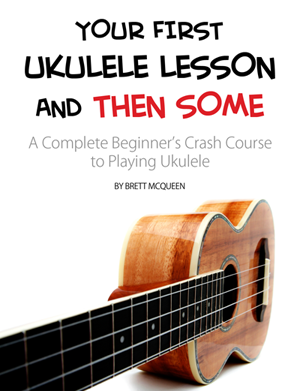Barre chords can be the hardest kinds of chords to get down on the ukulele, but if you are able to play them, you unlock a whole new selection of chord variations and positions to choose from to add variety to those same old, boring chord progressions.
In this lesson, I give you some tips for your consideration that can help you play barre chords more cleanly and easily on the ukulele.
Incase you’re unfamiliar, when you play a barre chord, you are required to use a finger to fret or press down on multiple strings. Common examples of barre chords include: D7, Bm, Cm7 and Bb, as shown in the following diagrams.
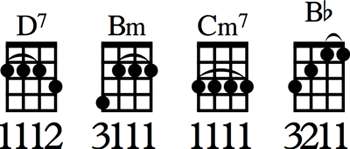
Barre chords can be quite hard to switch to and fret, but give these quick tips a try to conquer these chords and open up some new possibilities in your ukulele playing.
1. Check your thumb position.
A barre chord requires a bit more strength since you are pressing down multiple strings against the fretboard. To get the most leverage, ensure that the ball of your thumb is pressed firmly into the neck of the ukulele.
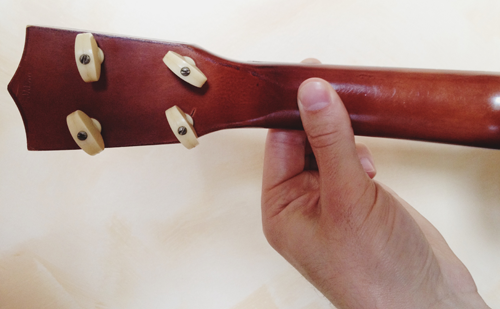
Use the ball of your thumb to press into the neck of the ukulele when playing a barre chord
2. Get closer to the fret.
Aim to press down as close to right behind the fret as possible – almost as if you are pressing right down on the fret. Avoid barring way behind the fret. You’re able to hold down the strings easier the closer your fingers are to the fret. See what I mean as I play a D7 chord in the following images.
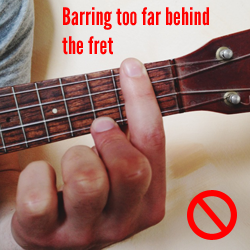
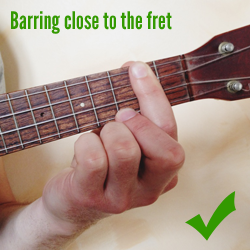
In the figure on the right, it might seem as if the strings wouldn’t ring out clearly with my index finger that close on the fret, but I’ve positioned my finger so I maximize the leverage against the strings and get every string to ring out clearly.
3. Skip the half barre and use a full barre.
Some chords like Bb only require a half barre to play the chord, where your only barring the bottom two strings rather than all four on a fret. It can be hard to get the pressure you need with a half barre, so consider using a full barre instead. I show an example of this specifically for the Bb chord in this lesson here.
4. Double up your barre.
This isn’t always a feasible option, but in some cases, it can be helpful to lay your middle finger behind your index finger as you barre the strings. This makes your barre stronger and can allow the strings to ring out more clearly. This really only works for minor and minor 7th barre chords though (like Bm7, Cm7, C#m7).
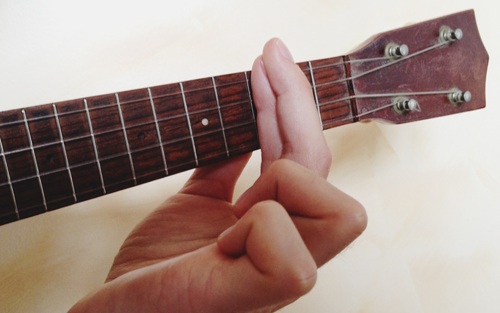
Using both index and middle fingers to barre a Cm7 chord on the ukulele
5. Isolate dead notes and adjust.
If you can’t get a barre chord to ring out, hold down the chord and pluck each individual string to see which note or notes aren’t ringing out. From there, experiment with adjusting the position of your barre on the strings. For example, to play some barre chords, you might focus on barring the strings with the bottom two knuckles of your finger, where you have a bit more meat and flesh to press down on the strings, rather than using the top two knuckles to barre the strings. The key is to be aware of these nuances, experiment and see what works best for you.
The following two images show me playing a D7 barre chord but I’m experimenting with the position of the barre using different knuckles on my finger to hold down the strings.
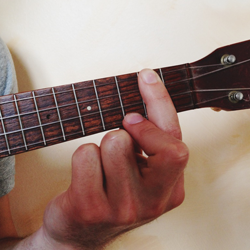
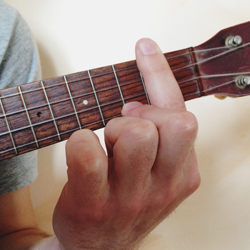
6. Find an alternate position.
Typically, on the ukulele, you perform a barre with your index finger. However, you might find that using your middle finger works better in the context of certain chord progressions. For example, to play a D7 chord, I often like to use my middle finger to barre the 2nd fret and press down my ring finger on the 3rd fret of the bottom string, as shown in the following image.
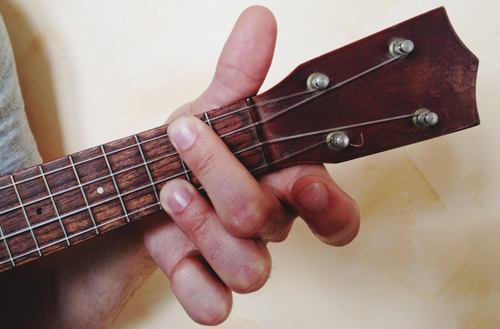
7. Build strength with simple exercises.
If you’re finding that you’re still not able to get the hang of barre chords, be patient with yourself, because it takes a fair degree of strength in your fretting hand to hold down a barre. With time and practice, you find that playing barre chords is easier.
To help build strength, when you’re not playing the ukulele, you might take a tennis ball and practice squeezing it with a high degree of pressure for a few seconds and then relaxing. Repeat this a few times. It might seem like a pretty basic exercise, but it can certainly help you build strength in your fretting hand.
Remember: The key in all of this is to practice and experiment. It takes time and a lot of trial and error to play barre chords cleanly and smoothly. Some of these barre chords are downright awful to play, so be patient with yourself and keep at it.
What steps have you taken to improve your barre chords? What tips do you have for beginners who are struggling with barre chords? Let’s hear it! Post your comment below.

